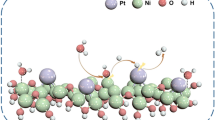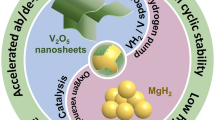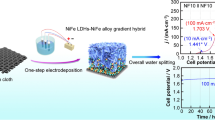Abstract
Metal-semiconductor nanoheterostructure (NHS) exhibits fascinating catalytic performance due to the strong metal-support interaction (SMSI). SMSI in liquid-solid heterogeneous catalysis based on NHS was rarely investigated as compared to the gas-solid counterpart. Two issues, namely, the wet-chemical preparation of monodisperse model catalyst and in-situ characterization on the electronic structure, are challenging and studied here. The size of the metal catalyst was finely tuned in a Pd-Fe2O3 NHS and electrochemical test revealed that the electronic states differ significantly in liquid environment from in vacuum. The combined amendments resulted in a more reliable conclusion on the SMSI in Suzuki coupling. This study might give some clues on the illusive in-liquid structure-property relationships.
摘要
金属-氧化物型纳米异质结构可能存在界面间的电子和物质传输, 因而导致性能的提升, 目前得到广泛的关注. 对于这类金属-氧化物型纳米异质结构在催化反应中的结构-效能关系, 以往的研究存在以下不足之处: 一方面对于尺寸的控制还有欠缺, 不能合成尺寸可控的单分散样品; 另一方面, 对催化剂电子结构的表征主要停留在真空或气相环境, 而液相原位表征方法亟待发展. 本研究工作发展了一种甲酰胺溶剂合成体系, 可以尺寸连续可调地合成一系列钯-氧化铁纳米异质结构和单独的钯纳米晶. 利用这些模型催化剂, 结合液相电化学测试方法, 我们原位研究了它们的电子结构, 并发现在真空和液相环境中, 这些催化剂的电子结构有明显差异. 这表明传统的真空表征方法可能会造成与真实构效关系的偏离. 本研究表明, 高质量的模型催化剂和原位表征方法对于研究构效关系都是至关重要的. 这对于发展高效的金属-氧化物型液-固异相催化剂具有一定的启示意义.
Similar content being viewed by others
References
Carbone L, Cozzoli PD. Colloidal heterostructured nanocrystals: synthesis and growth mechanisms. Nano Today, 2010, 5: 449–493
Costi R, Saunders AE, Banin U. Colloidal hybrid nanostructures: a new type of functional materials. Angew Chem Int Ed, 2010, 49: 4878–4897
Li Y. Nanoparticle chemistry upgrades catalytic in-terfaces in noble metal catalysts. Sci China Chem, 2014, 57: 924–925
Tauster SJ, Fung SC, Garten RL. Strong metal-support interactions. Group 8 noble metals supported on titanium dioxide. J Am Chem Soc, 1978, 100: 170–175
Tauster SJ. Strong metal-support interactions. Acc Chem Res, 1987, 20: 389–394
Fu Q, Wagner T. Interaction of nanostructured metal overlayers with oxide surfaces. Surf Sci Rep, 2007, 62: 431–498
Yang H. Ji S, Liu X, Zhang D, Shi D. Magnetically recyclable Pd/gamma-AlOOH@Fe3O4 catalysts and their catalytic performance for the Heck coupling reaction. Sci China Chem, 2014, 57: 866–872
George SM. Introduction: heterogeneous catalysis. Chem Rev, 1995, 95: 475–476
Clark JH, Macquarrie DJ. Heterogeneous catalysis in liquid phase transformations of importance in the industrial preparation of fine chemicals. Org Proc Res Dev, 1997, 1: 149–162
Shekhar M, Wang J, Lee WS, et al. Size and support effects for the water-gas shift catalysis over gold nanoparticles supported on model Al2O3 and TiO2. J Am Chem Soc, 2012, 134: 4700–4708
Metin O, Ho SF, Alp C, et al. Ni/Pd core/shell nanoparticles supported on graphene as a highly active and reusable catalyst for Suzuki-Miyaura cross-coupling reaction. Nano Res, 2013, 6: 10–18
Li C, Fan F, Yin B, et al. Au+-cetyltrimethylammonium bromide solution: a novel pre-cursor for seed-mediated growth of gold nanoparticles in aqueous solution. Nano Res, 2013, 6: 29–37
Cargnello M, Doan-Nguyen VVT, Gorgon TR, et al. Control of metal nanocrystal size reveals metal-support interface role for ceria catalysts. Science, 2013, 341: 771–773
Dasgupta NP, Liu C, Andrews S, Prinz FB, Yang P. Atomic layer deposition of platinum catalysts on nanowire surfaces for photoelectrochemical water reduction. J Am Chem Soc, 2013, 135: 12932–12935
Schweinberger FF, Berr MJ, Döblinger M, et al. Cluster size effects in the photocatalytic hydrogen evolution reaction. J Am Chem Soc, 2013, 135: 13262–13265
Toebes ML, van Dillen JA, de Jong KP. Synthesis of supported palladium catalysts. J Mol Cata A Chem, 2001, 173: 75–98
Alayoglu S, Krier JM, Michalak WD, et al. In situ surface and reaction probe studies with model nanoparticle catalysts. ACS Cata, 2012, 2: 2250–2258
Nowotny J, Bak T, Sheppard LR, Nowotny MK. Reactivity of titanium dioxide with oxygen at room temperature and the related charge transfer. J Am Chem Soc, 2008, 130: 9984–9993
Atkinson RJ, Posner AM, Quirk JP. Adsorption of potential-determining ions at the ferric oxide-aqueous electrolyte interface. J Phys Chem, 1967, 71: 550–558
Zhang S, Nguyen L, Zhu Y, et al. In-situ studies of nanocatalysis. Acc Chem Res, 2013, 46: 1731–1739
Frenkel AI, Rodriguez JA, Chen JG. Synchrotron techniques for in situ catalytic studies: capabilities, challenges, and opportunities. ACS Cata, 2012, 2: 2269–2280
Xu B, Zhang Z, Wang X. Formamide: an efficient solvent to synthesize water-soluble and sub-ten-nanometer nanocrystals. Nanoscale, 2013, 5: 4495–4505
Jia CJ, Sun LD, Yan ZG, et al. Single-crystalline iron oxide nanotubes. Angew Chem Int Ed, 2005, 44: 4328–4333
Peng HC, Xie S, Park J, Xia X, Xia Y. Quantitative analysis of the coverage density of Br-ions on Pd{100} facets and its role in controlling the shape of Pd nanocrystals. J Am Chem Soc, 2013, 135: 3780–3783
Miyaura N, Suzuki A. Palladium-catalyzed cross-coupling reactions of organoboron compounds. Chem Rev, 1995, 95: 2457–2483
Littke AF, Fu GC. Palladium-catalyzed coupling reactions of aryl chlorides. Angew Chem Int Ed, 2002, 41: 4176–4211
Reetz MT, Breinbauer R, Wanninger K. Suzuki and Heck reactions catalyzed by preformed palladium clusters and palladium/nickel bimetallic clusters. Tetra Lett, 1996, 37: 4499–4502
Maegawa T, Kitamura Y, Sako S, et al. Heterogeneous Pd/C-catalyzed ligand-free, room-temperature Suzuki-Miyaura coupling reactions in aqueous media. Chem A Eur J, 2007, 13: 5937–5943
Ellis PJ, Fairlamb IJS, Hackett SFJ, Wilson K, Lee AF. Evidence for the surface-catalyzed Suzuki-Miyaura reaction over palladium nanoparticles: an operando XAS study. Angew Chem Int Ed, 2010, 122: 1864–1868
Zhang Z, Yates JT. Band bending in semiconductors: chemical and physical consequences at surfaces and interfaces. Chem Rev, 2012, 112: 5520–5551
Bruix A, Migani A, Vayssilov GN, et al. Effects of deposited Pt particles on the reducibility of CeO2(111). Phys Chem Chem Phys, 2011, 13: 11384–11392
Min BK, Friend CM. Heterogeneous gold-based catalysis for green chemistry: low-temperature CO oxidation and propene oxidation. Chem Rev, 2007, 107: 2709–2724
Morrison SR (ed.). Electrochemistry at Semiconductor and Oxidized Metal Electrodes. New York: Plenum Press, 1980
Ye M, Gong J, Lai Y, Lin C, Lin Z. High-efficiency photoelectrocatalytic hydrogen generation enabled by palladium quantum dots-sensitized TiO2 nanotube arrays. J Am Chem Soc, 2012, 134: 15720–15723
Mazeina L, Navrotsky A. Enthalpy of water adsorption and surface enthalpy of goethite (α-FeOOH) and hematite (α-Fe2O3). Chem Mater, 2007, 19: 825–833
Li J, Zhu S, Li Y, Wang, F. Water adsorption on Pd {100} from first principles. Phys Rev B, 2007, 76: 235433
Hesleitner P, Kallay N, Matijevic E. Adsorption at solid/liquid interfaces. 6. The effect of methanol and ethanol on the ionic equilibria at the hematite/water interface. Langmuir, 1991, 7: 178–184
Wang ED, Xu JB, Zhao TS. Density functional theory studies of the structure sensitivity of ethanol oxidation on palladium surfaces. J Phys Chem C, 2010, 114: 10489–10497
Bargar JR, Kubicki JD, Reitmeyer R, Davis JA. ATR-FTIR spectroscopic characterization of coexisting carbonate surface complexes on hematite. Geo Cosmo Acta, 2005, 69: 1527–1542
Lin Y, Yuan G, Sheehan S, Zhou S, Wang D. Hematite-based solar water splitting: challenges and opportunities. Energy Environ Sci, 2011, 4: 4862–4869
de Vries JG. A unifying mechanism for all high-temperature Heck reactions. The role of palladium colloids and anionic species. Dalton Trans, 2006, 421–429
Pérez-Lorenzo M. Palladium nanoparticles as efficient catalysts for Suzuki cross-coupling reactions. J Phys Chem Lett, 2011, 3: 167–174
Molnár Á. Efficient, selective, and recyclable palladium catalysts in carbon-carbon coupling reactions. Chem Rev, 2011, 111: 2251–2320
Yang J, Ying JY. Nanocomposites of Ag2S and noble metals. Angew Chem Int Ed, 2011, 50: 4637–4643
Ho VTT, Pan CJ, Rick J, Su WN, Hwang BJ. Nanostructured Ti0.7Mo0.3O2 support enhances electron transfer to Pt: high-performance catalyst for oxygen reduction reaction. J Am Chem Soc, 2011, 133: 11716–11724
Gross E, Somorjai G. The impact of electronic charge on catalytic reactivity and selectivity of metal-oxide supported metallic nanoparticles. Top Catal, 2013, 56: 1049–1058
Author information
Authors and Affiliations
Corresponding author
Additional information
Biao Xu was born in 1987. He received the PhD degree in Chemistry from Department of Chemsitry, Tsinghua University, Beijing, China, in 2014. His research interests include synthesis, assembly, characterization and application of nano heterostructure.
Xun Wang was born in 1976. He received the PhD degree in Chemistry from Department of Chemistry, Tsinghua University, Beijing, China, in 2004. Currently, he is a professor at the Department of Chemistry, Tsinghua University. His research interests include synthesis, assembly, characterization and application of ultrathin nanomaterials. His main awards include the Finalist for the IUMRS-MRS Singapore Young Researchers Award (2014), Science and Technology Award for Chinese Youth (2009), National Fund for Outstanding Young Scientists (2007) and IUPAC Prize for Young Chemists (2005).
Electronic Supplementary Material
Rights and permissions
About this article
Cite this article
Xu, B., Yang, H., Zhou, G. et al. Strong metal-support interaction in size-controlled monodisperse palladium-hematite nano-heterostructures during a liquid-solid heterogeneous catalysis. Sci. China Mater. 57, 34–41 (2014). https://doi.org/10.1007/s40843-014-0001-3
Received:
Accepted:
Published:
Issue Date:
DOI: https://doi.org/10.1007/s40843-014-0001-3




